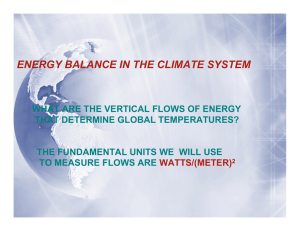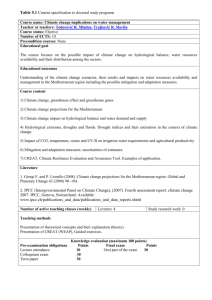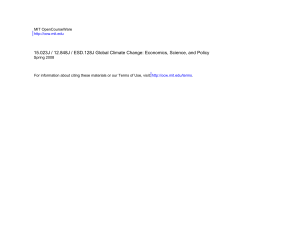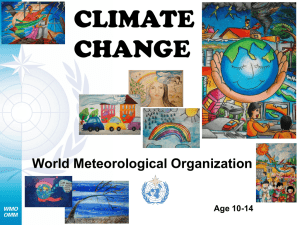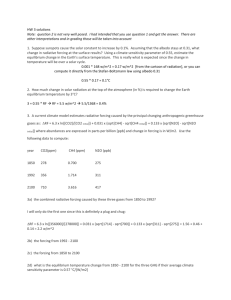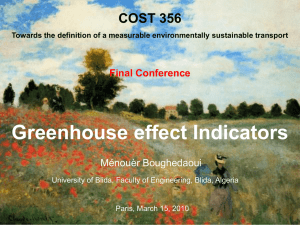Energy: Perspectives, Problems and Prospects
advertisement
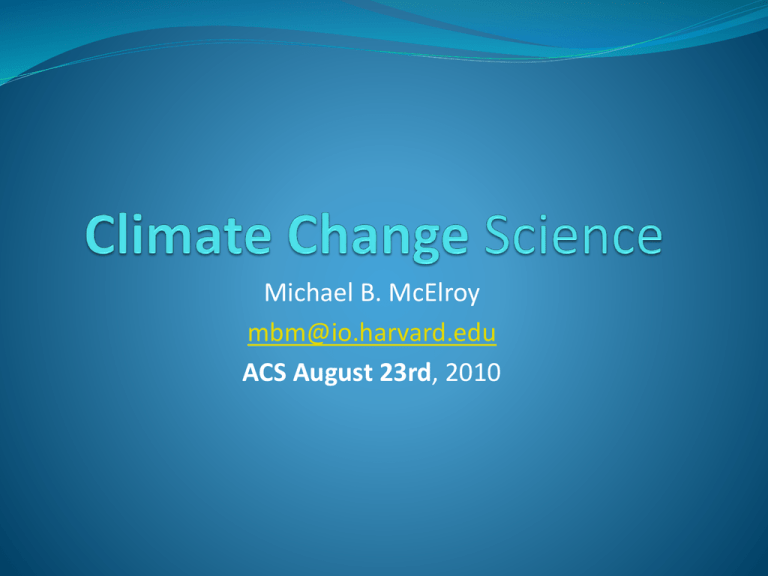
Michael B. McElroy mbm@io.harvard.edu ACS August 23rd, 2010 Estimate of the Earth’s annual and global mean energy balance: 30 % of incident solar energy is reflected back to space. 70 % is absorbed. Rate at which energy is absorbed globally = 1.23x1017 W. Total rate at which energy is consumed globally by humans (435quad = 4.61x1020J) is less than energy absorbed from sun by a factor of 8500. In a steady state, the energy absorbed from the sun should be equal to the energy radiated to space. Assume earth radiates as a black body at an average temperature. Then T=255K. Globally averaged vertical temperature profile Radiation of energy to space takes place from the mid-troposphere, from an altitude of about 5km. This illustrates the significance of the greenhouse effect. In the absence of infrared absorbing agents in the atmosphere, radiation to space would originate from the surface. The global average temperature in this case would be almost 40K lower than is the actual situation today. Conclusion: The greenhouse effect is responsible for about a 40K increase in global average surface temperature. Infrared-absorbing gases (greenhouse gases) in the atmosphere in order of importance are: H2O, CO2, CH4, O3, N2O, and Halocarbons Concentrations of greenhouse gases are increasing rapidly, at a rate unprecedented at least over the past 650,000 years, due to diverse forms of human activity. Changes in concentrations of the greenhouse gases CO2 (red), CH4 (blue), and N2O (green) From IPCC (2007). Concentrations and contribution to radiative forcing over the past 20,000 years for (a) CO2, (b) CH4, and (c) N2O: From IPCC (2007). Monthly mean atmospheric carbon dioxide (red curve) at Mauna Loa Observatory, Hawaii. Cumulative CO2 Emission: Top 10 Countries in 2007 CDIAC, 2007 11 Atmospheric CO2 concentrations as observed at Mauna Loa from 1958 to 2008 (black dashed line) and projected under the 6 SRES marker and illustrative scenarios. Summary of the principal components of the radiative forcing of climate change. From IPCC (2007) Radiative forcing at an average rate of 1.6 W∙m-2 would imply that the earth is gaining energy at a rate 57 times greater than the rate associated with total global commercial consumption of energy ! If emission of sulfur (largely from the use of coal) were eliminated, contemporary radiative forcing could be as large as 3 W∙m-2, more than 100 times current global commercial consumption of energy. A significant fraction (up to 80 %) of the excess energy absorbed by the earth has been stored in the ocean (over the depth range 0-700m): From IPCC (2007). Important radiative feedbacks: Changes in H2O vapor (+) Changes in cloud cover (+ and -) Changes in CH4 (likely +) Changes in sea ice (likely +) Changes in land use (+ and -) Changes in upper troposphere and stratosphere H2O (probably +) The key challenge for models is to accurately account for these feedbacks. From James E Hansen (NASA GISS). From James E Hansen (NASA GISS). From James E Hansen (NASA GISS). Climate Change Issues: Global average temperature likely to continue to increase. H2O vapor content of atmosphere likely to increase. While global precipitation may not increase very much, likely that it will be distributed differently both in space an time: more floods and more droughts. Destabilization of Greenland and Antarctic ice combined with increases in ocean temperature may be expected to cause a continuing rise in sea level: rise could occur very rapidly. Warming of Arctic tundra could trigger a major increase in release of CH4. Potentially serious changes in availability of fresh water in specific regions. Special cases of China, Pakistan, India, Mexico, and Sahel. Decrease in Arctic sea ice cover. Multi-model means of surface warming (relative to 1980-1999) for the scenarios A2, A1B, and B1, shown as continuations of the 20th century simulation. From IPCC 2007 Multi-model mean of annual mean surface warming (surface air temperature change, °C) for the scenarios B1 (top), A1B (middle) and A2 (bottom), and three time periods, 2011 to 2030 (left), 2046 to 2065 (middle) and 2080 to 2099 (right). From IPCC 2007 Immediate challenge is to reduce the rate of increase in emission of primary greenhouse gases: Decreasing emissions of SO2, NOx may exacerbate anticipated future radiative forcing. Renewable sources of energy (wind, solar, biomass, hydro and geothermal) and nuclear can potentially substitute for carbon emitting fossil sources. Carbon capture and sequestration? Greater reliance on electricity produced from non-carbon sources? Further discussion of these issues in Energy: Perspectives, Problems and Prospects published by Oxford University Press 2010.
